Before you reach for the flea comb or book that emergency vet appointment, let’s paws-itively chill for a sec and talk scabs. Yeah, those crusty little bumps that might be plaguing your feline friend’s usually pristine fur. So How To Treat Scabs on Cats ?
I know, I know. Seeing your cat sporting a constellation of scabs is enough to make any cat parent’s heart sink like a hairball in the washing machine.
But before you panic and picture yourself drowning in vet bills, let’s take a deep breath and scratch this itch together.
Because scabs on cats are actually pretty common. They can be caused by a whole bunch of reasons, from those pesky fleas feasting on your kitty’s skin like a furry buffet, to allergies making their fur cry out in protest.
Heck, even a playful scratch or a tumble from the bookshelf can leave your cat sporting a temporary battle scar. But the good news? Most scab situations are totally treatable!
And that’s where this blog comes in.
1. Understanding Scab On Cats
What if you find your cat scratching your couch, you may ignore that for a while. But, if you notice your pet scratching or biting a specific spot of the body, that can make you think about your beloved feline companion.
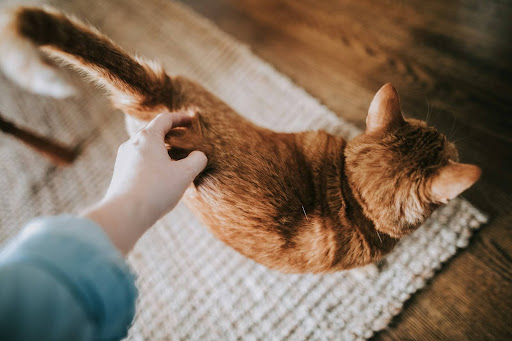
If you look into them closely, you will notice a sore or wound in that specific area. Before you freak out, let me explain what those wounds are and how you can get rid of those shored skin from the cat.
a) What are those cat scabs on the skin?
This question may have crossed your mind, like many pet parents. A scab is a hard layer of skin over any wound. First of all, it’s not a disease. But it indicates that your cat was wounded or hurt, and to naturally heal it, a protective layer is formed on the wounded area.
It’s like the body’s natural healing process to treat any inflamed wound. They can be found in any part of the body, mostly where cats can reach and scratch easily, like the back, neck, or tails.
b) Are they symptoms of any disease?
Scabs are not a disease of cats. In fact, they are pretty common issues in cats. Cats can be wounded by any means, or they can hurt themselves by biting or scratching.
Scabs can be different in size and color depending on the cause of their formation. Sometimes it can be the cause of any hidden disease of the cat that you should be concerned about.

2. What causes scab on the cat’s skin?
When you see scabs on your cat’s skin you may wonder ‘’what causes scab on the cat’s skin?”. The answer is quite long. Read Should You Pick Scabs Off Cats ? A Vet’s Guide
Also Several factors can be the reason for those mighty scabs. These factors are–
a) Underlying health issue
It’s always a good idea to consult with a veterinarian if your cat dealing with some health issues.
Mainly scabs are caused by allergies. Common reasons for allergies are bug bites, fleas, mites and lices. These allergies mainly cause itching which can lead to skin rashes. Some cats really enjoy staying outdoor. But, If your cat stays indoors most of the time, another thing causes scabbing and bleeding, that is miliary dermatitis.
Another common issue among cats is fungal infection from ringworm. So, checking out what is causing scabbing on your cat is very important in maintaining a healthy feline health.
b)Potential causes
You can check the environment where your cat lives. Any blood-sucking pest can bite your cat and that can cause scabbing and bleeding. Sometimes cats can be allergic to any particular food, and medication. These can also lead to skin rashes and develop scab on the skin.
Another thing you need to figure out if your cat is stressed or scared for a particular reason.
When cats are heavily stressed, they continuously lick and scratch. This can cause scabbed skin and, in fact, sometimes lead to bald spots, dry patches, and even hair loss from that affected area.
c) External causes
Sometimes cats are attacked by other insects from outside or, get hurt externally. These are some causes of scabbed skin on cats:
- Parasites: Lice, fleas, and ticks make cats licking and scratching when they bite cats. You wouldn’t believe cats with flea allergies can develop severe irritation from one flea bite.
- Allergies: Sometimes cats have allergies to dust, pollen, food, and medication. This can make them irritated and they tend to scratch their body parts.
- Injuries: If the cat is hurt during playing or other activities, they may bleed and scab on the part. Sometimes cats have arthritis and they lick their painful area. This may result in soared skin.
3. How can you identify your cat has a scab?
Now that you know what can cause scabbing on the cat’s skin, the next part is identifying them. But how can you do that? You can find out how to spot them correctly with the following methods:
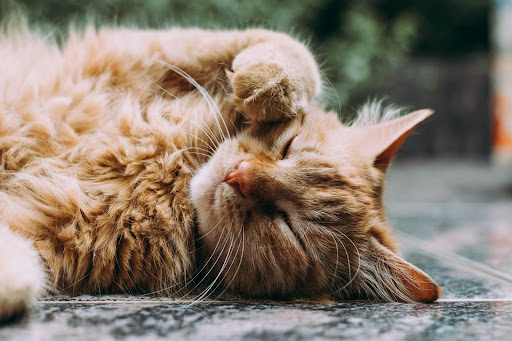
a) Checking wounds
To check if your cat has any sore skin, gently part the cat’s fur and look at it closely. When you touch your cat, you can feel a strong and hard layer of irritated skin under the fur. They can be tiny, red, brown, and sometimes black, covered by fur. Sometimes, they affect larger areas, and then you see them without touching them.
Scabs can be in the form of small or large bumps or dry patches. If you find any scabs, you should not pick or scratch them.
b) Sore caused by miliary dermatitis
If you see your cat has lesions that look like millet seeds then, mostly your cat is affected by miliary dermatitis. ‘Miliary’ words came from the word millet. Hence, they resemble red bumps on the head, neck, chin, ear, and tail. The cat’s ear area is delicate and hair-free. Sometimes ear area is affected by ear mites.
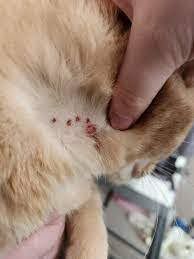
Another thing is, this area is affected by edge milari dermatitis. To ensure if your cat has miliary dermatitis you can see these show symptoms. When you detect the cause earlier, treating them becomes easy. Those symptoms are–
- Excessive grooming: When you see your cat excessively scratching and grooming.
- Intense itching: If you see those red bumps and the cat is constantly itching , licking, and scratching that affected area.
- Bald patches: The affected area will develop bald patches. Hair loss and hair thinning in that area are commonly seen.
- Skin inflammation: Those skin areas may will get inflamed, and you can also notice swelling and rashes.
- Behavioral change: Soared skin makes cats uncomfortable. So, you may see your cat behaving weirdly and irritated due to pain and itching.
These common symptoms will help you to identify the problem. When you see these, it’s important to take the necessary steps or proper medication to get rid of these issues immediately.
c) Effect of fleas
Cats have extreme grooming habits may affected by fleas. When fleas bite cats, they develop allergies to flea saliva. This condition is known as flea allergy dermatitis.
Mostly head, and back areas develop lots of rashes, that cause itchiness and irritation. Kitties start to get more itchy and make the condition worse by injuring themselves.
When you catch your kitty struggling with a flea allergy, it’s super important to take steps to eliminate the flea from your cat’s living area. You can use topical flea treatment consulting with your vet. There are some ways you can try at home also.
4. How can you treat them?
Dealing with those health issues can make you worried. But let me assure you, with our guidance, you can treat your kitty and give her an itch-free life. Before you start scratching your head, take a look at the treatment options you can go for.
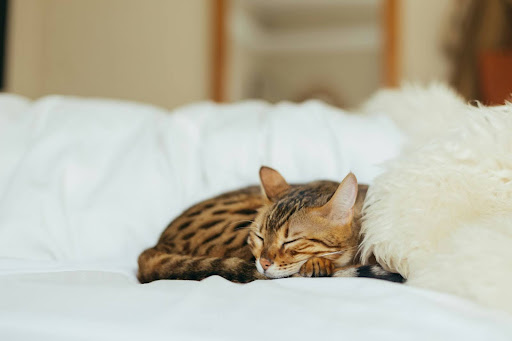
a) Home remedies
Remember, scabs are there for a reason. Sometimes these simple hacks can give your cat temporary relief from the discomfort. There are several things you can try for your kitty at home.
Including the following steps:
- Epsom salt bath: You can give your beloved furry friend a bath with Epsom salt. Therefore, you will get the chance to clean the wounded part, and it is an inexpensive way to give your cat quick itch relief. Warm water will soothe the healing scabs and help to reduce swelling.
- Oatmeal: Oatmeal has healing properties. If you can give your cat a warm oatmeal bath and keep them in the warm water for at least 3 to 5 minutes, if your cat likes it, A warm bath helps to soften the crusty patches and remove itchiness, while your cat will enjoy the fancy feel of the spa.
- DIY Spray: You can also make oatmeal and calendula spray if you cannot make your cat ready for the bath. Make a DIY by boiling some calendula in the water. Next, add oatmeal to it and spray it on the cat scab. Let it sit for 30 minutes before you rinse it with plain water.
- Coconut oil: Coconut oil is considered to have anti-inflammatory and anti-bacterial properties. You can put some extra virgin coconut oil on the wounded area topically and make sure your cat does not lick it. Though you can also add it to your cat’s diet by consulting with your vet, and if your cat likes it.
b) Clinical treatment
When you find your cat is having too much pain and initial home treatments are not helping you enough, you can opt for these options:
✓ Flea allergies: Consult with a veterinarian about your pet and take medication as he prescribes. You can look for omega-3 supplements and antihismaties for the cat, and you can also look for an oatmeal shampoo to ease the itchiness.
✓ Food allergies: Talk with a nutritionist if you think it’s necessary. Check your cat’s diet and remove any food that has been added recently and is causing rashes or itchiness, making the condition worse.
✓ Infection from worms: If your cat has infections from ringworms, your pet doctor can suggest some oral medications and give some topical cream. When you use the topical cream, make sure your cat does not lick it, as it tends to clean it by licking.
5. What else you can do?
For safety concerns, you can put some extra effort or your kitty. Additionally, these tips can help your kitty to heal faster:
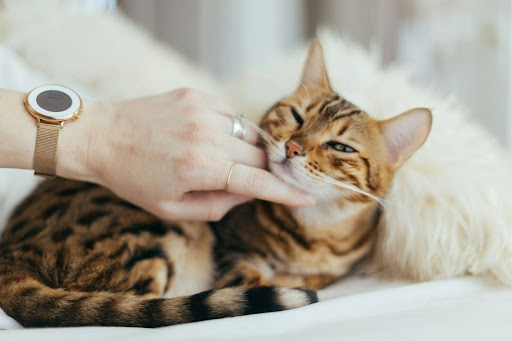
- Cleaning environment: Even you take proper medication, you need to clean the bedding of the cat with antiseptic solutions and use flea spray to keep the space safe. Also, look for any store-bought option to keep your cat mites free.
- Applying Sudocrem: Keep a sudocrem near you.When you see your cat got hurt or have a minor cut, or it is suffering from excessive sunburn, you can rub this healing ointment on the affected area and make it less painful.
Final Thought
We arrived at the conclusion of our discussion. Finally, as a pet parent, it is your responsibility to ensure that your feline is healthy. Scabs are not particularly scary diseases.
However, if you find out what is causing it, you can treat it by removing the source. I am confident that with care and patience, as well as the guidance we have provided, you will be able to completely ensure your feline’s health.
If you have any further questions about your kitty, please leave a comment. You can also share this article with anyone concerned about scabs on their cat’s skin.

